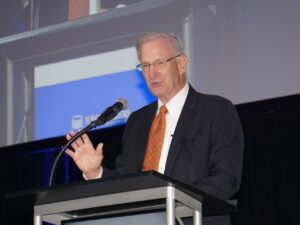
Whenever there is a banking crisis, bankers get blamed, but a former FDIC Vice Chair and 38-year Federal Reserve veteran told bankers the real culprits are those propagating undisciplined fiscal policy and bad monetary policy. Speaking at the Iowa Bankers Association convention in Des Moines Sept. 18, Thomas Hoenig said the last three major crises were caused by huge increases in federal spending and reactionary increases in interest rates that wreaked havoc on the economy and at the nation’s banks.
“History shows that bad fiscal policy, bad monetary policy will undermine a nation faster than anything,” Hoenig told bankers gathered at the Veterans Memorial Auditorium. Hoenig said that after crises in 1980 and 2008, bankers suffered along with business owners and consumers. “And who got the blame? Were any new disciplines implemented on fiscal policy? Any new rules on monetary policy? No. Who got the blame? The bankers,” Hoenig said.
A distinguished senior fellow at the Mercatus Center at George Mason University in Fairfax, Va., Hoenig explained regulatory policy is disproportionately burdensome on community and regional banks. Observing that regulatory burden is driving industry consolidation, the Fort Madison, Iowa native called the cost of regulation a major industry challenge.
Hoenig, a former president of the Federal Reserve Bank of Kansas City, said additional rules for banks tend to be the result of a banking crisis. He cited the example of the Dodd-Frank Act after the crisis of 2008. He said the rules are particularly damaging because often they don’t apply to other lenders. “And now after the most recent crisis they are talking about additional regulations and the ones most affected will be the regional and community banks,” he said.
Also challenging for community bankers is the increased cost of doing business because of uneven regulatory expectations regarding capital adequacy. Community banks typically operate with equity capital of 10 percent or more, while the largest banks are operating on 7 percent capital, Hoenig explained. This allows the largest banks to operate at a relatively lower cost than smaller banks. Citing the too-big-to-fail advantage the largest banks enjoy, Hoenig said the largest banks should be required to hold more capital. He said he doesn’t believe higher capital requirements would result in those banks lending less.
Citing the payments system as a key industry challenge, Hoenig called on bankers to work together to establish the industry’s own payments platform, independent of the established payment rails. He said customers want to be able to conduct banking transactions on their electronic devices and that bankers need to be where their customers want to do business. He said companies such as Apple and Amazon are prepared to spend enormous sums of money to gain a prominent place in the payments arena.
Hoenig urged bankers to pay attention to discussion coming out of the FDIC proposing changes to the way it considers applications for mergers. “I find it interesting that after the industry has consolidated to where the largest five to seven institutions now have more than half the industry’s total assets, that they now propose changing the merger criteria,” he said. The proposal, he said, would presume any proposed merger to be anti-competitive and puts the responsibility on the parties involved to demonstrate otherwise. Hoenig said it is a reversal of current policy, and that if passed, he doubts it would withstand a court challenge.
